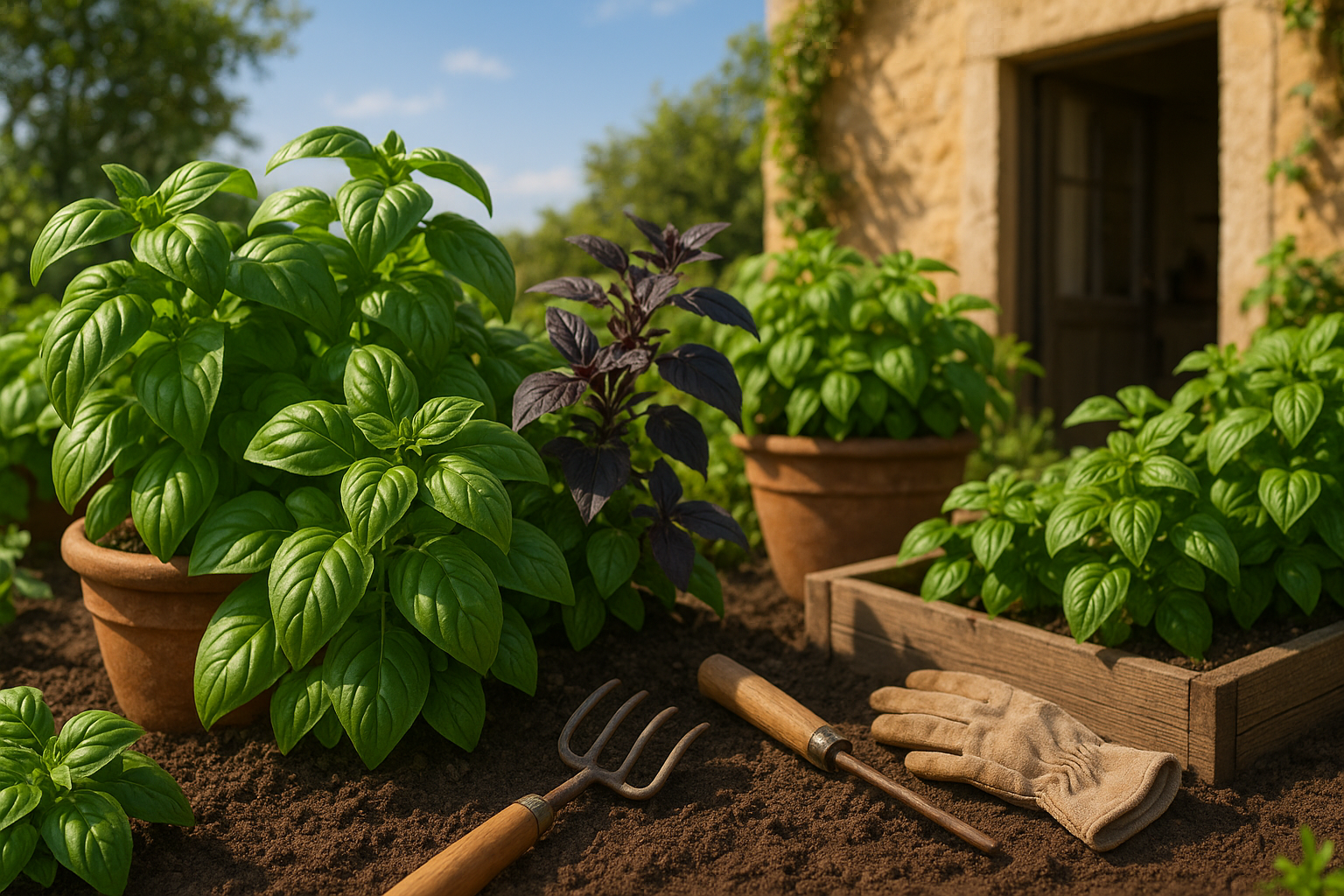Introduction to Growing Basil Outdoors
Learning how to grow basil outdoors is one of the best entry points for anyone new to gardening. Basil is incredibly beginner-friendly: it grows quickly, thrives in pots or garden beds, and rarely demands expert care. Plus, it’s a staple in kitchens around the world—the fresh, aromatic leaves can transform everything from homemade pesto and salads to pizza and pasta, making it one of the most popular herbs among home cooks and gardeners alike.
If you’re dreaming of picking handfuls of fragrant basil just steps from your kitchen, you’re in the right place. In this guide, we’ll walk you through what makes basil such a rewarding herb for outdoor growing, how to choose the right spot and soil, and tips for planting—from seeds or seedlings—so you get lush, healthy plants all season.
We’ll also cover how to care for your basil with the right watering and sun exposure, tricks to keep it producing more leaves, and the simplest ways to harvest for maximum flavor. Whether you live in an apartment with a sunny balcony or have a larger backyard plot, these easy steps will help you fill your garden and your meals with fresh basil in no time.
Choosing the Right Basil Variety
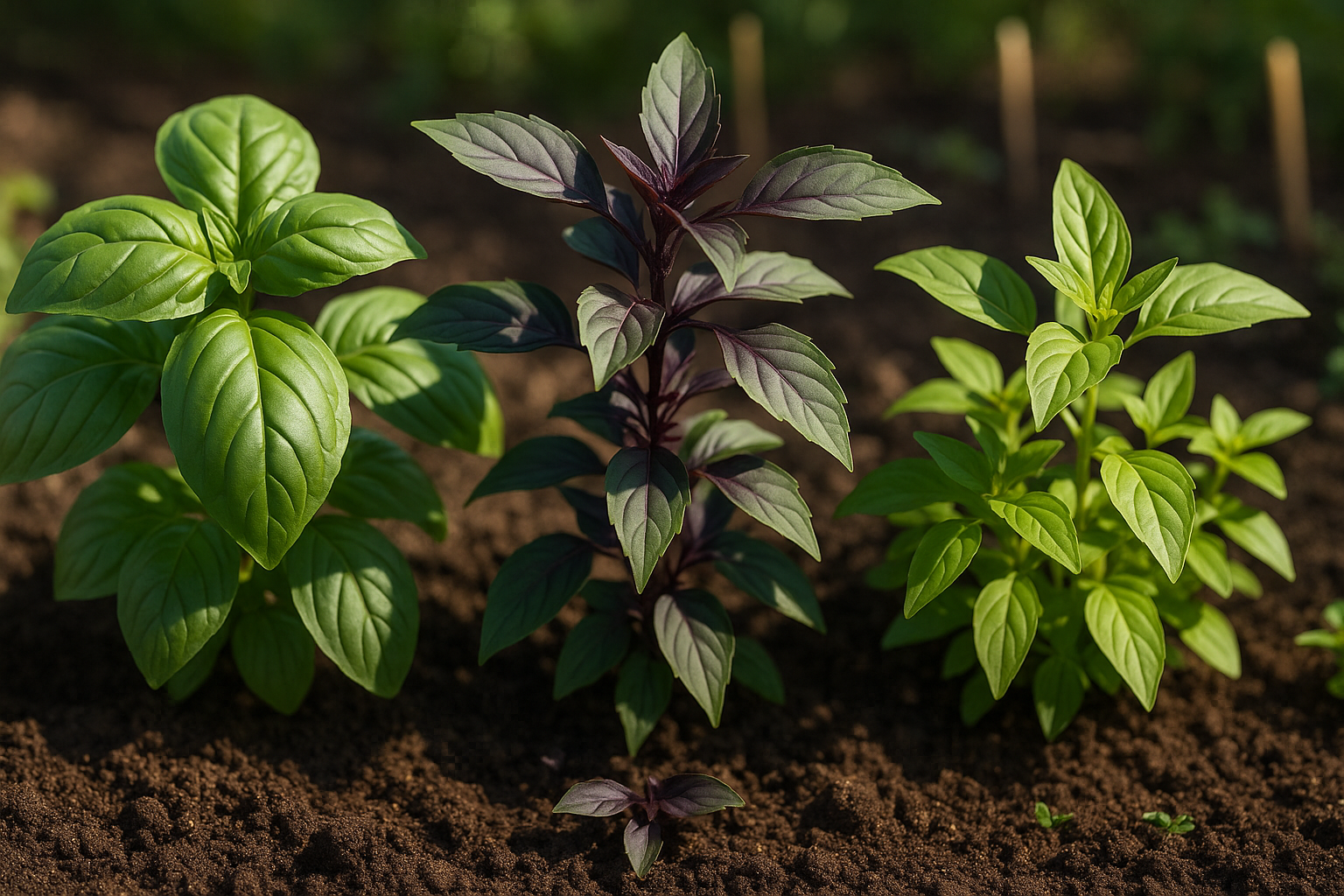
When it comes to growing basil outdoors, choosing the right variety can make all the difference in your gardening experience and the flavors you enjoy in your kitchen. The classic Genovese basil is a favorite for beginners and seasoned gardeners alike, thanks to its robust, sweet flavor—perfect for pesto, salads, and Italian dishes. Its large, tender leaves grow quickly and abundantly, making it a forgiving option for those just starting out.
If you’re looking to add a unique twist to your meals, Thai basil offers a spicy, licorice-like taste that works beautifully in stir-fries and curries. Plus, its purple stems and pointed leaves add ornamental interest to garden beds. Lemon basil is another easy-to-grow variety, beloved for its refreshing citrus aroma and bright, zesty flavor that pairs well with seafood and summer drinks.
When selecting a basil variety, consider your culinary preferences, the size of your growing space, and each plant’s growth habit:
- Genovese basil grows wide and bushy.
- Thai basil stays more upright.
- Lemon basil can handle cramped quarters in containers.
Picking the right type ensures you maximize your harvest and get leaves that suit your favorite recipes. Don’t be afraid to experiment with a couple of varieties to see what thrives in your garden and on your plate.
Site Selection and Soil Preparation
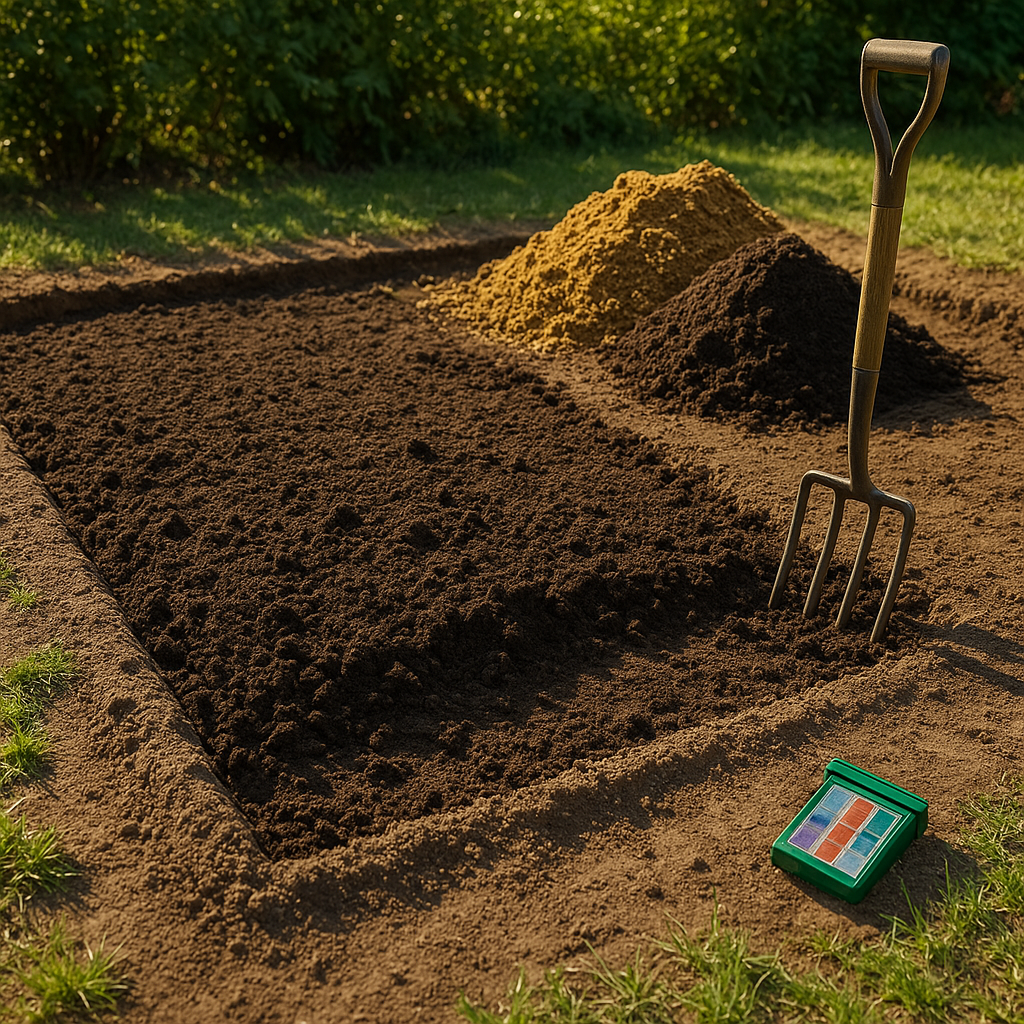
Choosing the right location for your outdoor garden makes all the difference when it comes to healthy, thriving plants. Start by scouting an area that receives at least six to eight hours of direct sunlight daily, as most vegetables and flowers need ample light to grow strong and productive. Avoid spots overshadowed by trees or fences, and watch for areas that collect standing water after rain—good drainage is key to preventing root rot.
If your yard is especially windy, choose a place with some natural shelter or add a simple windbreak, like a row of shrubs, to protect delicate stems. Once you’ve found your spot, focus on soil preparation. Begin by clearing away weeds and debris, then loosen the soil to a depth of about 12 inches with a spade or garden fork so roots can stretch with ease.
Mixing in compost or well-rotted manure not only boosts nutrients but also improves soil texture for better drainage and water retention. Don’t forget to check your soil’s pH—many plants prefer a range between 6.0 and 7.0. Inexpensive soil test kits are widely available at garden centers.
For beginners, raised beds offer a simple way to bypass poor native soil, allowing you full control over the growing medium. They warm up faster in spring, offer excellent drainage, and reduce back strain during planting and weeding. In-ground beds, on the other hand, may cost less to establish and work well if your soil is already healthy, though they generally require more effort upfront to amend.
Start small and choose the method—raised or in-ground—that matches your yard, soil, and time commitment. With a thoughtful site and healthy soil, you’ll lay the groundwork for a successful, low-stress gardening experience.
Sowing and Planting Basil Outdoors
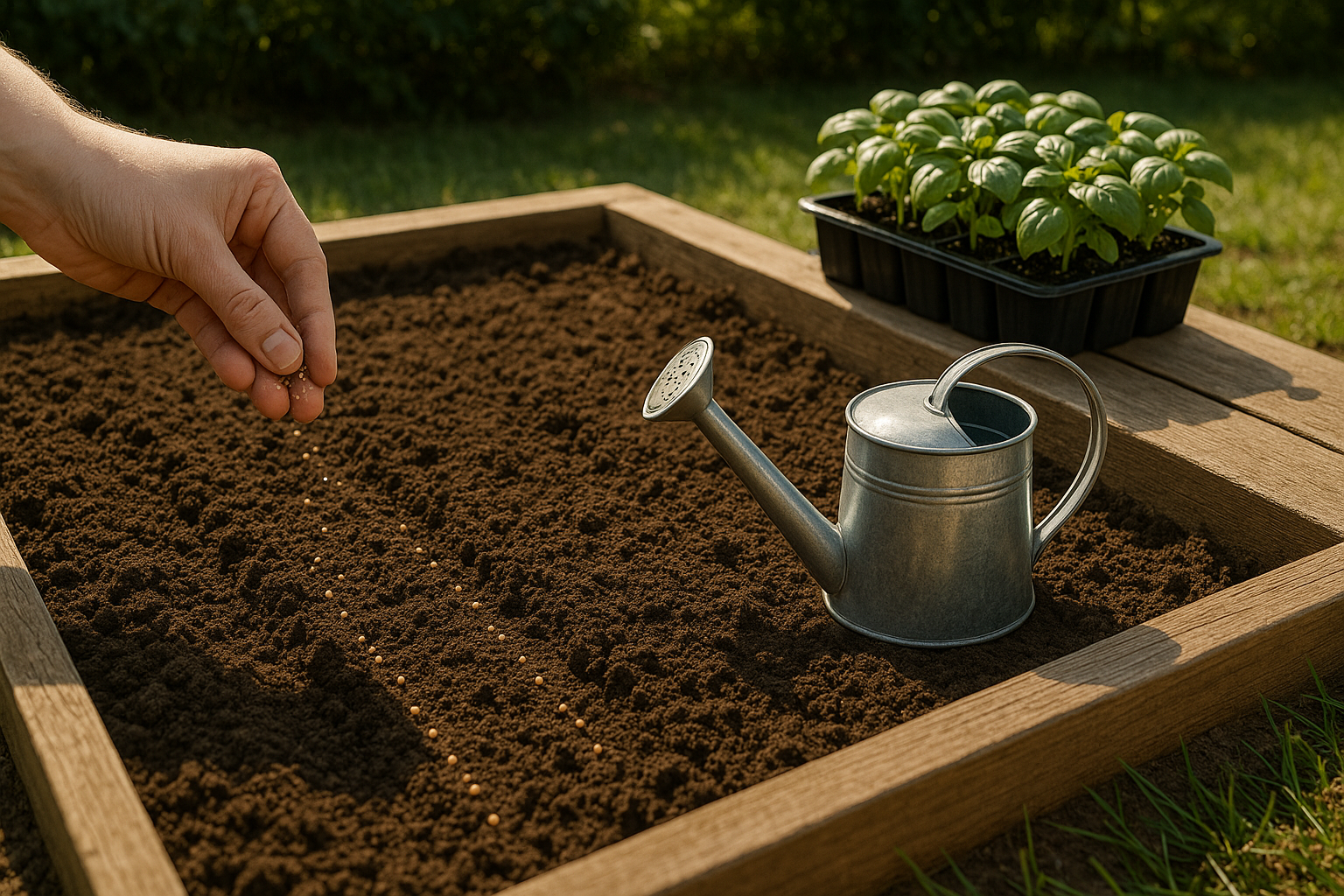
Growing basil outdoors begins with choosing between directly sowing seeds in the garden or starting them indoors and transplanting healthy seedlings later. Direct sowing is simple—once your region’s last expected frost date has passed and the soil is warm (about 70°F or 21°C), you can sow basil seeds straight into the garden. This typically occurs in late spring for most climates.
Clear the area of weeds, loosen the soil, and sprinkle seeds about ¼ inch deep. Space seeds about 12 inches apart to promote strong airflow and bushy plants. Water gently and keep the seedbed moist until seedlings emerge, usually within 7 to 10 days.
For an earlier harvest, start seeds indoors about 4 to 6 weeks before your local frost date. Use seed-starting trays or small pots filled with a light seed mix. Sow seeds just ¼ inch deep, mist to moisten, and cover with plastic wrap until germination. Place the trays in a warm, bright location or under grow lights.
Once seedlings develop their second set of leaves and outdoor temperatures remain above 50°F (10°C), harden them off by gradually introducing them to outdoor conditions over a week. Then, transplant the basil to the garden, keeping each plant about a foot apart to avoid crowding.
Water freshly planted basil at the base, being careful not to splash the leaves, and mulch lightly to lock in moisture. Whether sowing directly or transplanting, consistent moisture and plenty of sunlight (6 hours or more per day) will give your basil a healthy, fragrant start.
Basil Care
Caring for basil is easy once you establish a reliable routine for watering, feeding, and pruning. Basil prefers consistently moist—but not soggy—soil. Check the top inch of soil with your finger; if it feels dry, it’s time to water. This usually means watering every 2-3 days for potted basil, or once to twice a week for garden basil, depending on the weather. Avoid wetting the leaves to reduce the risk of disease.
Feeding basil is just as straightforward: use a balanced, water-soluble fertilizer (such as 10-10-10 NPK) diluted to half strength, and apply it every 3-4 weeks during the growing season. Be careful not to overfeed, as this can cause lush but weak foliage. Organic options like fish emulsion or compost tea are excellent for slow, steady growth.
Pruning and Pinching
Pruning and pinching are key to creating a bushier, more productive basil plant. Pinch off the tips of stems when the plant has three or four sets of true leaves; this encourages two new shoots to grow from the pinch point, resulting in a fuller, bushier plant. As the plant grows, regularly remove the top two sets of leaves just above a leaf node (where the leaves join the stem).
If you see flower buds forming, pinch them off immediately. Flowering signals the plant to focus on reproduction rather than leaf production, which often causes leaves to turn bitter.
By incorporating these simple steps—water when the soil feels dry, feed monthly with a gentle fertilizer, and prune just above leaf nodes—you’ll enjoy a steady harvest of fragrant, flavorful basil all season long. Remember, healthy basil thrives on regular attention, so check your plant often and adjust care as needed based on weather, pot size, and growth rate.
Harvesting and Storing Basil
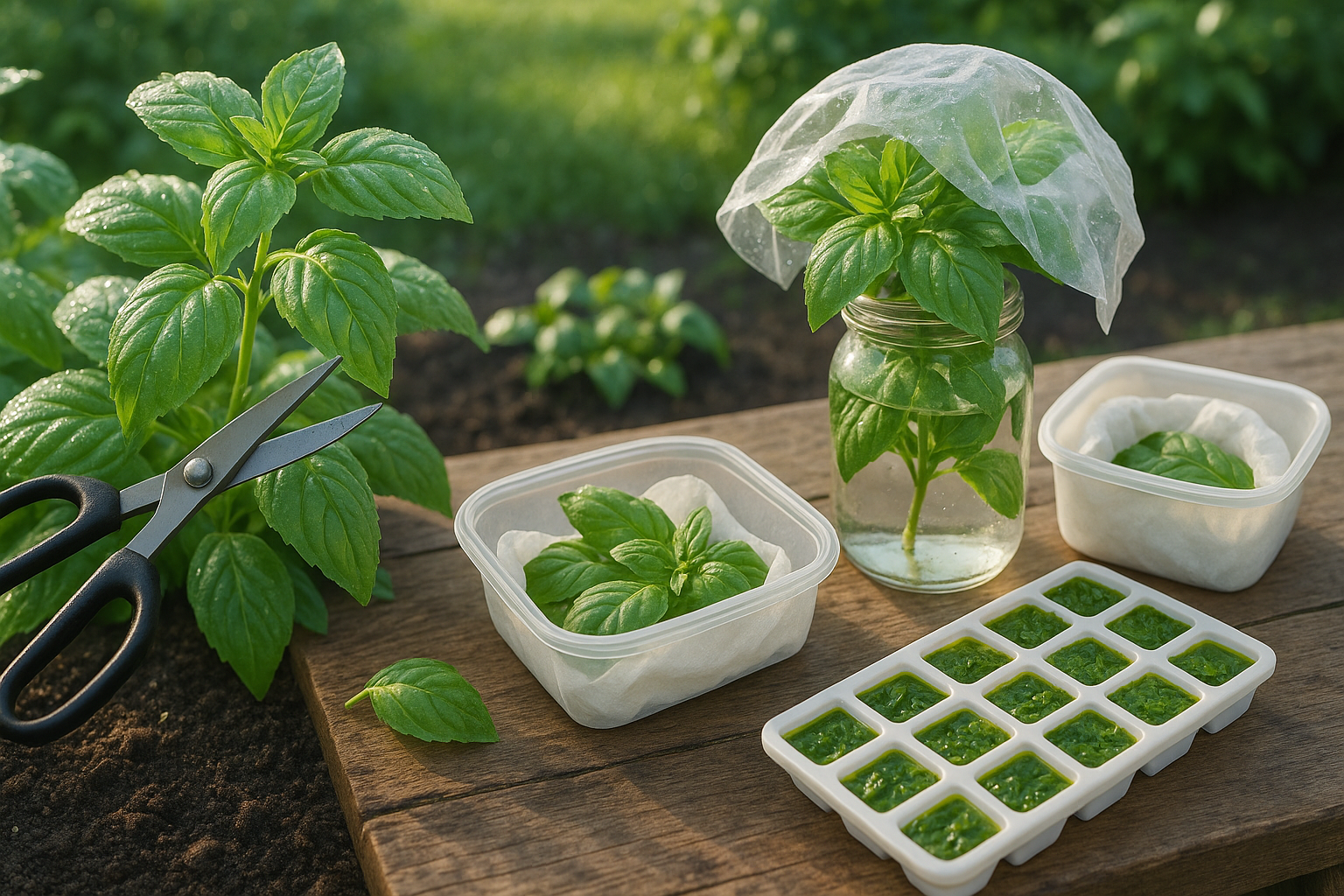
Harvesting basil at the right time is key to lush, ongoing growth throughout the season. The best time to pick basil is in the morning after the dew has dried but before the midday sun makes the leaves wilt. Always harvest before the plant starts to flower; simply pinch or cut just above a pair of healthy leaves using clean scissors or your fingers.
Regular pruning every one to two weeks encourages your basil plant to become bushier and produce more leaves.
For immediate use, fresh basil adds an instant burst of flavor to salads, pizzas, and pasta—just tear or chiffonade the leaves and sprinkle them on your dish.
Storage Options
If you have more basil than you can use, there are several smart storage methods:
- Short-term: Place harvested stems in a glass of water on the counter and loosely cover with a plastic bag, or wrap leaves in a slightly damp paper towel and refrigerate in a container for up to a week.
- Long-term: Freezing is the best way to preserve flavor—chop basil, pack it into ice cube trays with a bit of olive oil or water, and freeze. These cubes can be dropped straight into soups and sauces.
- Drying: Air-dry small bundles upside down in a cool, dark place, or use a dehydrator for efficiency. Dried basil is perfect for spice blends or homemade pesto.
No matter how you store it, having a stash of basil means summer’s vibrant taste is always within reach.
Common Problems and Troubleshooting
Outdoor basil can face several challenges, but with a proactive approach, most problems are manageable. One frequent issue is pest infestation—aphids, Japanese beetles, and slugs love basil’s tender leaves. Inspect plants regularly, picking off pests by hand or using a gentle spray of soapy water to deter them.
Fungal diseases like powdery mildew and downy mildew thrive in damp, overcrowded conditions; space your basil plants at least 12 inches apart to improve airflow and water early in the morning to allow leaves to dry.
Sudden weather changes such as unexpected frosts or heatwaves can also harm basil. Cover plants with row covers during cold snaps and mulch heavily in hot spells to help maintain stable soil temperatures and moisture.
Try to avoid overwatering, as basil prefers slightly dry soil—let the top inch dry out before watering again. If your basil looks wilted or yellowed due to issues like overwatering or fertilizer burn, remove damaged leaves and give the plant a short break from fertilizing to help it recover.
Organic remedies such as neem oil or homemade garlic spray can address insect and disease problems without harming pollinators or the environment.
Remember, healthy basil starts with good habits: rotating crops each year, using clean tools, and trimming leaves regularly keeps your basil robust and productive all season long.
Optional
Fresh basil is a game-changer in the kitchen, and you don’t need to be a chef to make the most of your harvest. For starters, blend basil leaves with olive oil, garlic, Parmesan, and pine nuts for a quick homemade pesto that’s perfect on pasta, sandwiches, or as a dip.
If you’re craving something light and refreshing, layer sliced tomatoes, mozzarella, and basil leaves to make a classic caprese salad—drizzle with balsamic glaze for extra flavor.
But basil isn’t just for eating! Try arranging sprigs with other garden herbs for fragrant kitchen bouquets that double as natural air fresheners. You can also place basil leaves in bowls near windowsills or doorways to help repel flies and mosquitoes, using the plant’s natural oils as a gentle pest deterrent.
Don’t be afraid to get creative—float a few leaves in your lemonade, infuse them into vinegar or olive oil, or even freeze them in ice cubes for a pretty drink garnish. Growing basil opens up a world of possibilities, so experiment freely and see where your inspiration—and your taste buds—take you.
